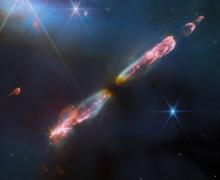Listen to today's episode of StarDate on the web the same day it airs in high-quality streaming audio without any extra ads or announcements. Choose a $8 one-month pass, or listen every day for a year for just $30.
You are here
Interstellar Probe
The Sun travels through the galaxy inside its own “bubble.” The bubble is generated by the Sun’s magnetic field, and it’s filled with charged particles carried by the solar wind. Our knowledge of conditions outside the bubble is limited. But a team of scientists is outlining a mission that would change that.
Interstellar Probe would reach a thousand times the distance between Earth and the Sun — seven times farther than any spacecraft has yet ventured. From that range, it would measure magnetic fields, cosmic rays, dust particles, and much more in the interstellar medium — the stuff between the stars. And it would look back toward the solar system to see how the Sun’s bubble interacts with the interstellar medium.
So far, our only looks at interstellar space have come from Voyagers 1 and 2. They were launched in 1977 to explore the giant outer planets. They’re still operating today. And both have passed beyond the Sun’s magnetic bubble. Voyager 1 is at 150 times the Earth-Sun distance — by far the most remote working spacecraft ever.
Interstellar Probe would use a new “super-booster” and a gravitational kick from Jupiter to reach that distance in about a decade. And it would reach its target range in about 50 years.
The mission wouldn’t launch until the 2030s at the earliest. If it takes flight, it could give us our first good look at interstellar space.
Script by Damond Benningfield






